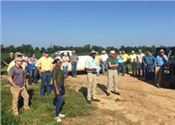|
Row Rice, Nematodes Featured At Field Tour

Participants listen to an on-farm presentation during a recent field tour
and training program in Morehouse Parish.
Photo by Tara Smith/LSU AgCenter
MER ROUGE, LA.
Experts from the LSU AgCenter, United States Department of Agriculture Natural Resource Conservation Service and Farm Service Agency, and Louisiana Department of Agriculture and Forestry highlighted agriculture production best management practices and pest management concerns facing producers in northeast Louisiana during an interagency field tour and training held July 18.
“Farmers have enough challenges without filtering through numerous contacts to get the answers they need,” said Rogers Leonard, LSU AgCenter associate vice president for plant, soil and water programs.
“We all work for the same stakeholder – the farmer,” Leonard said. “And we want to ensure that producers are directed to the best source of information.”
More than 60 agents, consultants and inspectors took part in the all-day training.
“This field tour presents a vital opportunity for agencies in the region to work together to address crosscutting concerns facing our stakeholders,” said AgCenter regional director Tara Smith.
The tour featured several on-farm demonstrations in Morehouse Parish, beginning at Jason Waller Farms near Mer Rouge.
“The rolling crop tour provides a unique opportunity to showcase field demonstrations conducted in our area and supports collaboration and information and idea exchange with other agencies,” said AgCenter Morehouse Parish agent Richard Letlow.
Row rice production is not currently an AgCenter-recommended production practice, but having an enthusiastic producer who wanted to compare cost and profitability of nontraditional irrigated row rice with conventional flooded paddy rice production encouraged area agents to move forward with the study, Letlow said.
This is the second year Waller has collaborated with AgCenter experts to look at row rice data.
“We have been keeping detailed records and meeting weekly, and it looks great,” Letlow said. “But we won’t have final yields and cost data until after the mid-August harvest.”
The tour continued at the Paul Wiggins farm with a large-scale soybean demonstration on root-knot nematode management.
Because the field had a major root-knot nematode problem last year, AgCenter plant pathologist Charles Overstreet used site-specific nematicide technology to compare a resistant soybean variety and a higher-yielding susceptible variety to see how profitability might be affected.
“In untreated check plots, I found plants that were very badly galled with the higher-yielding susceptible soybean variety,” Overstreet said. “But the resistant variety had no galls at all; zero, very clean, beautiful resistance.”
On plots treated with a fumigant, Overstreet said he would expect to find low galling but will have to wait until harvest to analyze the final treatment response.
A herbicide demonstration in dicamba-tolerant soybeans on the Tony Hanes farm compared treatments with no dicamba to treatments with dicamba, said AgCenter agronomist Josh Copes.
The dicamba treatments showed better control of Palmer amaranth compared with non-dicamba treatments, he said.
The tour concluded with an informational tour of the Kennedy Rice Mill led by plant manager Marley Oldham.
In addition to seeing how raw rice is milled into brown and white rice, the group learned how rice by-products are used and how final products are shipped by rail.
Other field tour presentations included:
• NRCS water quality specialist Steve Nipper provided program updates, and NRCS civil engineer Jacob Paul discussed irrigation designs and programs.
• AgCenter rice specialist Dustin Harrell gave a rice crop and industry report.
• AgCenter cotton and corn specialist Dan Fromme presented a crop and industry report on both commodities.
• AgCenter economist Naveen Adusumilli provided a water policy update.
• AgCenter soybean specialist Todd Spivey was introduced and provided industry updates.
• LDAF pesticide and environmental programs director Kevin Wofford addressed growing regulatory concerns with new technologies and provided an update on dicamba and 2,4-D-related issues.
• Wofford also reviewed projected market year average prices and how Agriculture Risk Coverage and Price Loss Coverage programs payments scheduled for October release may be affected.
• John Lovelace, lower Mississippi assistant director with U.S. Geological Survey Gulf Water Science Center, presented an update on the Mississippi Alluvial Plain project about the Mississippi alluvial aquifer and water withdrawals in Louisiana. ∆
|
|